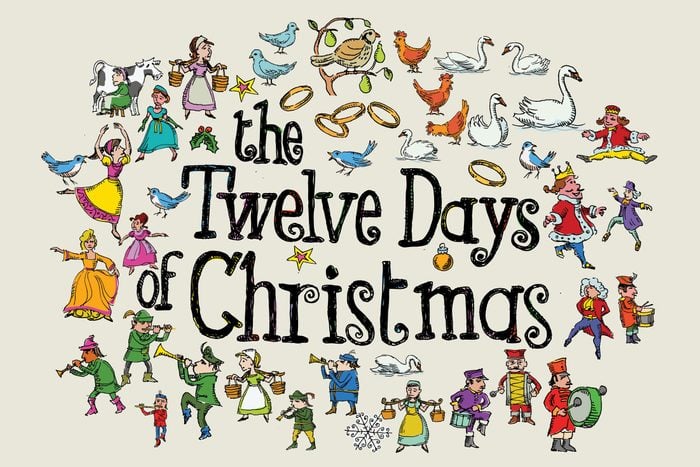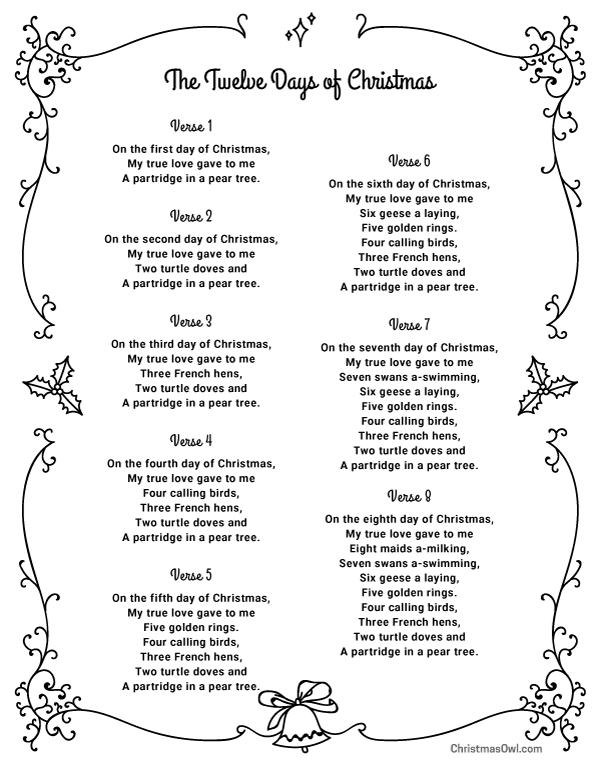The Twelve Days of Christmas: A Lyrical Journey Through Time
Related Articles: The Twelve Days of Christmas: A Lyrical Journey Through Time
- The Twelve Days Of Christmas: A Hilarious 2024 Parody
- The 12 Days Of Christmas: A Modern-Day Gift Guide For 2024
- The Twelve Days Of Christmas: A Symphony Of Avian Delights
- 12 Days Of Christmas: A Fashion Extravaganza For 2024
- 12 Days Of Christmas Activities For Work 2024: A Festive Guide To Spread Holiday Cheer
Introduction
With enthusiasm, let’s navigate through the intriguing topic related to The Twelve Days of Christmas: A Lyrical Journey Through Time. Let’s weave interesting information and offer fresh perspectives to the readers.
Table of Content
Video about The Twelve Days of Christmas: A Lyrical Journey Through Time
The Twelve Days of Christmas: A Lyrical Journey Through Time

The beloved Christmas carol, "The Twelve Days of Christmas," has been captivating audiences for centuries with its whimsical lyrics and enigmatic imagery. While its origins remain shrouded in mystery, the song has evolved over time, gaining new interpretations and cultural significance. In this article, we delve into the lyrical genius of the 12 Days of Christmas, exploring its historical roots, symbolism, and enduring appeal.
Historical Origins and Evolution
The earliest known version of "The Twelve Days of Christmas" appeared in a French children’s songbook in the 18th century. Known as "Les Douze Jours de Noël," the song featured a cumulative list of gifts given on each of the twelve days between Christmas and Epiphany, a Christian feast day commemorating the arrival of the Magi.
As the song spread throughout Europe, it underwent various adaptations. In England, it was first recorded in a book of children’s games in 1780. The familiar tune we know today emerged in the 19th century, and the song became a staple of Christmas celebrations.
Lyrical Structure and Meaning
The song follows a simple cumulative structure, with each verse adding another gift to the list. The gifts, ranging from partridges in pear trees to golden rings, have been the subject of much speculation and interpretation.
Some believe the gifts represent the Twelve Fruits of the Spirit, as described in the Bible. Others suggest they symbolize the twelve days of creation or the twelve months of the year. The true meaning remains a mystery, adding to the song’s enduring fascination.
The Partridges in Pear Trees
The opening line of the song, "On the first day of Christmas, my true love gave to me: a partridge in a pear tree," has sparked countless debates. Partridges are not typically associated with pear trees, leading some to believe the lyrics are a corruption of "perdrix en poirier," French for "partridge in a partridge tree."
Another theory suggests that the partridge represents Jesus, while the pear tree symbolizes the cross. The partridge is a small, vulnerable bird, often associated with the nativity story. The pear tree, with its thorns, could represent the suffering endured by Jesus on the cross.
The Symbolism of the Gifts
Each gift in the song holds its own symbolic meaning. The turtle doves, for example, represent love and peace, while the French hens symbolize fertility and abundance. The five gold rings represent the five senses, and the eight maids-a-milking symbolize the eight beatitudes of the Sermon on the Mount.
The gifts become increasingly extravagant as the song progresses, culminating in the twelve drummers drumming. These gifts could represent the wealth and prosperity of the giver or the abundance of blessings bestowed upon the recipient.
Cultural Impact and Legacy
"The Twelve Days of Christmas" has had a profound impact on popular culture. It has been featured in countless films, television shows, and books. The song’s distinctive melody and repetitive lyrics have made it a favorite for choirs, caroling groups, and families around the world.
The song has also inspired numerous parodies and variations. One popular version, "The Twelve Pains of Christmas," humorously lists the annoyances and stresses associated with the holiday season. Another version, "The Twelve Days of Christmas Shopping," satirizes the consumerism that often accompanies Christmas.
A Timeless Classic
"The Twelve Days of Christmas" remains a beloved Christmas classic, enjoyed by generations of listeners. Its enigmatic lyrics, charming melody, and enduring symbolism have ensured its place as a timeless holiday tradition. Whether sung around the fireplace or performed on a grand stage, the song continues to capture the spirit of Christmas and bring joy to hearts around the world.
Additional Insights and Analysis
- The True Love: The identity of the "true love" in the song is never revealed. Some believe it represents God, while others suggest it is a romantic partner or even the spirit of Christmas itself.
- The Missing Gifts: Some versions of the song omit certain gifts, such as the three French hens and the four calling birds. These omissions may be due to regional variations or simply to keep the song from becoming too long.
- The Cumulative Effect: The song’s cumulative structure creates a sense of anticipation and excitement. Each new gift builds upon the previous ones, creating a crescendo of festive abundance.
- The Use of Repetition: The song’s repetitive lyrics are both memorable and hypnotic. The repetition of "On the first day of Christmas" and the subsequent gifts creates a sense of ritual and tradition.
- The Enduring Mystery: Despite its popularity and widespread appeal, the true meaning of "The Twelve Days of Christmas" remains a mystery. This ambiguity adds to the song’s charm and allows for endless interpretation and speculation.






:no_upscale()/cdn.vox-cdn.com/uploads/chorus_image/image/62615710/12dayspyramid.0.0.0.0.png)

Closure
Thus, we hope this article has provided valuable insights into The Twelve Days of Christmas: A Lyrical Journey Through Time. We thank you for taking the time to read this article. See you in our next article!